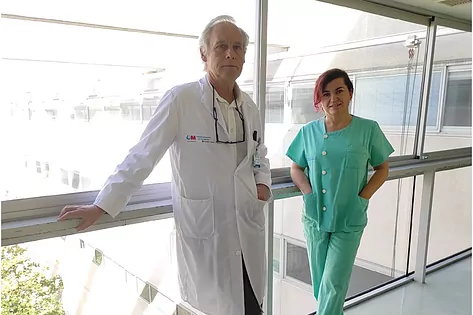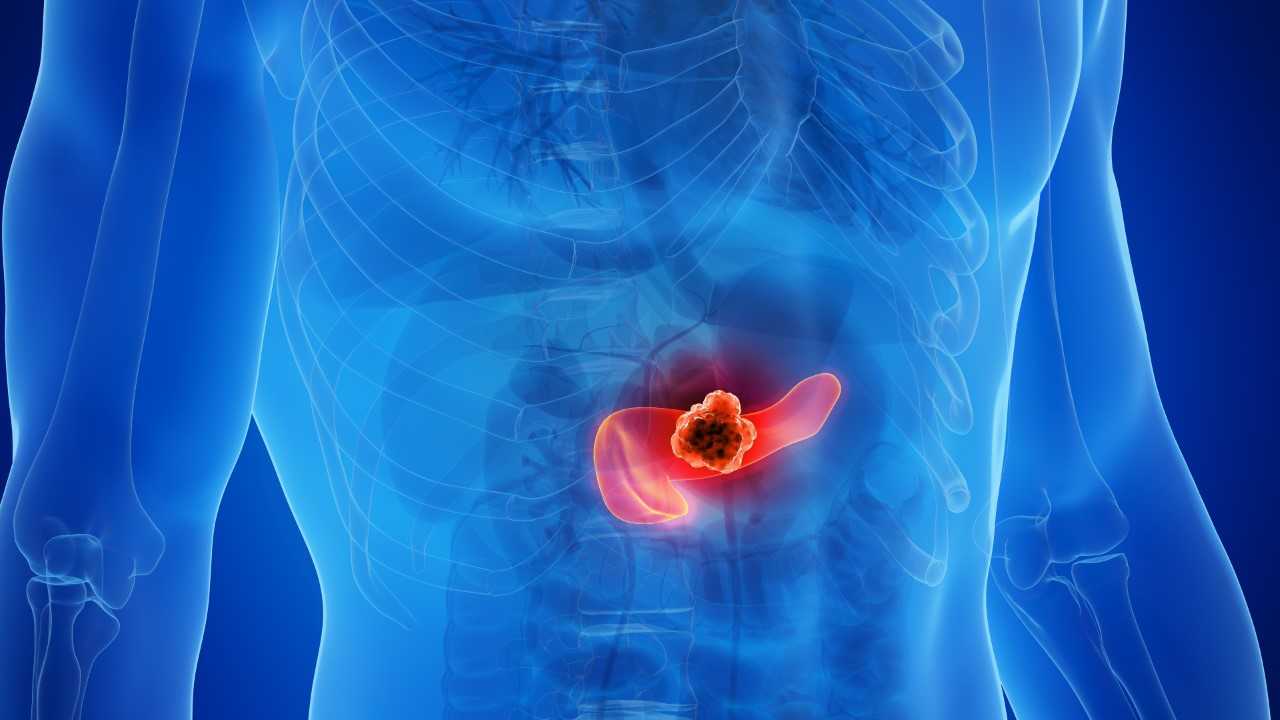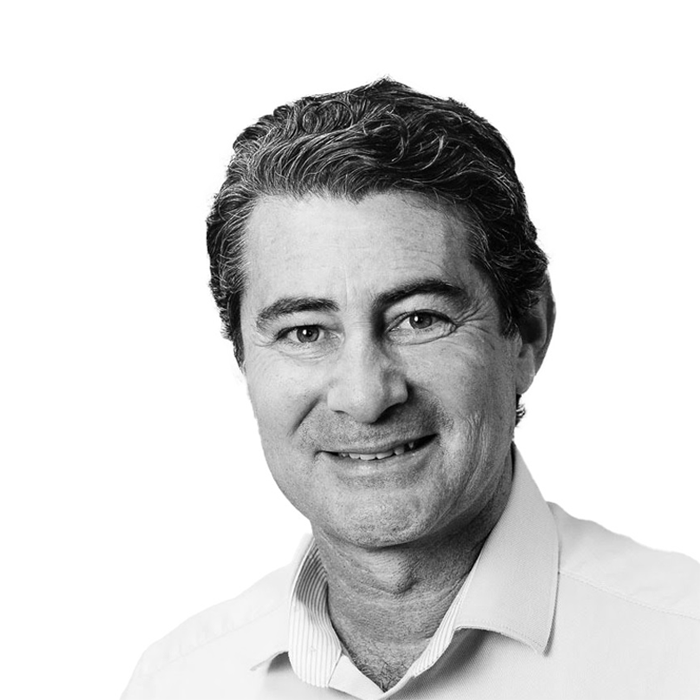News
Madrid hospital featured in Spanish newspaper El Mundo as it launches our innovative therapy against pancreatic cancer.

A multidisciplinary team from the University Hospital of Fuenlabrada, in Madrid, has applied an innovative treatment for locally advanced pancreatic cancer that offers fewer side effects compared to other therapies and whose objective is to reduce the tumor size so that, in the medium term, it is possible to perform its surgical removal.
It is a strategy that combines brachytherapy with radiopharmaceuticals: internal radiation in which, through an ultrasound-guided endoscopy, the active ingredient is injected into the tumor with a very controlled radiation, so that important doses are administered with minimal toxicity. The treatment is approved by the Spanish Agency for Medicines and Health Products (AEMPS) and available to the National Health System.
A patient -who now continues with the usual chemotherapy- has already undergone this process and has tolerated without complications the administration of this radioactive isotope, an initiative carried out for the first time in Spain within the international registry Osprey, a database that collects people diagnosed with this type of disease and where selected centers from different countries participate.
Fernando Pereira, head of the General Surgery and Digestive System Service of the University Hospital of Fuenlabrada, and principal investigator of the Osprey registry in this health center, explains to DM that it is the first time that the procedure is performed in Spain, although not internationally.
“Treatment with the Oncosil device was approved in Europe for clinical use in May 2020, following a prolonged preclinical phase and the presentation of the results of the pivotal PanCO study at the 2020 European Society of Medical Oncology (ESMO) World Congress. The PanCO study, conducted in Australia, Belgium and the United Kingdom between 2017 and 2018, included 50 patients from 10 centers, with consistently positive results compared to standard treatment regimens with chemotherapy or chemo-radiotherapy in these patients with locally advanced pancreatic cancer.”
URGENT NEED
In his opinion, in these patients there is “an urgent need to develop new therapies that help us improve outcomes.” Thus, the next step proposed to confirm these data has been the prospective, observational, and multicenter international Osprey registry (OncoSil Pancreatic cancer post-marketing clinical REgistrY), in which the data of patients undergoing implantation of the OncoSil device in real clinical practice will be recorded.
In this registry will participate several international centers and a few Spaniards of which the Hospital of Fuenlabrada has carried out the first treatments.
Pancreatic cancer is one of the tumors with the worst prognosis. It is estimated that half of the cases are metastatic to diagnosis and, therefore, only susceptible to palliative treatments.
“20% of the cases detected are susceptible to surgery, the ideal option and the only curative, while 30% correspond to those that are called locally advanced and in which there are currently several lines of research to reduce them and be able to apply surgical treatment”, such as the one developed by this Madrid hospital.
Regarding the percentage of tumor reduction expected to be achieved with this strategy in locally advanced lesions, Pereira explains that in the PanCO study a median reduction in tumor volume of 52% was observed. It is, therefore, “the one we hope to achieve”, although he stresses that, although the reduction of tumor volume is an important parameter to access surgery later, there are other variables to take into account.
“The metabolic response of the tumor itself – which is controlled by PET images – and the vascular relationships of these locally advanced tumors; that is, with the arteries and veins adjacent to the pancreas that are mainly responsible for these cancers not being able to be operated. In the PanCO study the rate of resection with curative intent was 23.8%, which is also what you would expect now.”
In this sense, the fact that the injected radioisotope -specifically Phosphorus 32– emits a beta radiation is very important because the side effects are minor and the tumor lesion will be receiving this millimeter radiation controlled for several months.
“It is important to emphasize that the side effects will be small based on what has been described in the first studies and remember that this therapy is carried out in The Day Hospital, so that the patient does not require hospital admission and can go home later,” added Virginia Peiró, assistant faculty of Nuclear Medicine at the University Hospital of Fuenlabrada.
COMPLEMENTARY STRATEGIES
Subsequently, the follow-up is carried out on a regular basis by the Medical Oncology Service. People who have undergone this new technique should continue with the chemotherapy treatment previously indicated, since both are complementary. This is the case of the first person treated in Fuenlabrada, who has tolerated the radiopharmaceutical approach without complications and continues with the usual chemotherapy.
Peiró explains that the choice of this particular isotope lies in the fact that the phosphorus-32 microparticles used in this treatment (OncosilTM) are a pure beta-emitting radioactive isotope. “This means that the radiation range is very small, specifically the average range in the tissue is 2.76 mm, which allows very high doses absorbed by the tumor, around 100Gy, as well as a good preservation of the surrounding healthy tissue.” The clinic means that the side effects are minor and the tumor lesion will be receiving this controlled millimeter radiation for several months.
The suspension of OncosilTM is prepared on the day of treatment in the Department of Nuclear Medicine and the amount of phosphorus-32 suspension to be implanted is calculated based on the tumor volume estimated in the imaging tests performed days before.
Iván Guerra, endoscopist of the Digestive System Service of the Fuenlabrada Hospital, explains to DM that the procedure is outpatient and the patient must prepare in the same way as for any digestive endoscopy procedure: fasting, with sedation and analgesia. It basically consists of performing an ultrasound-guided endoscopy where the lesion in the pancreas is identified, and through the endoscope channel, a fine needle is inserted that crosses the gastric or duodenal wall until it reaches the tumor. “
It is also important to have an experienced digestive echoendoscopist, since, according to Peiró, “the tumor usually has a capricious disposition, and for a correct placement of the implant, you have to avoid blood vessels and, often, also biliary prostheses”. Once the needle is in position inside the tumor, the Nuclear doctor implants manually through the echoendoscopy needle, the radioactive isotope.
The procedure usually lasts about 30 minutes, and when it ends, the patient is accompanied to the Day Hospital for observation until he fully recovers from sedation, “which usually happens an hour after finishing the treatment,” says Guerra. Peiró clarifies that “before discharging the patient, an SPET-CT scan image in Nuclear Medicine is also performed to confirm that the radiation has been administered in the correct location.”
ROLE OF CHEMOTHERAPY
Subsequent follow-up is usually carried out in Medical Oncology, since after the application of the technique it is necessary to continue with the chemotherapy treatment previously indicated.
It is a global strategy in which, according to Pereira, chemotherapy continues to play “a transcendental role, especially with the new schemes used in recent years, which have shown responses far superior to traditional schemes, although in order for patients to be used they must have an acceptable general condition. In fact, the first treatment that patients we select for Oncosil treatment receive is chemotherapy.”
The implantation of the radioisotope in the tumor is performed after the first or second cycle of chemotherapy, and then “chemotherapy is continued until the response control tests are performed, proceeding with surgical intervention if conditions allow,” says the head of the Digestive System.
Peiró recalls that the microparticles are a permanent implant and in their therapeutic use, 98% of the phosphorus-32 radiation will be released in a controlled way for about 81 days after implantation. “All this, together with the usual pattern of chemotherapy treatment that the patient does not abandon, probably allows a summative effect of the therapies.”
The analysis of the data offered by the Osprey registry will be able to specify who would be the most suitable candidates to receive this therapy. Peiró points out that approximately 50% of pancreatic cancer patients are diagnosed with distant metastases.
“In these, this strategy is not indicated; today they are only susceptible to palliative treatments with chemotherapy. Another 20% are considered operable at the outset, and in these, at least for the moment, this strategy is not proposed either because they are candidates for direct surgery. It is in the other 30%, what we call locally advanced, where this strategy would make sense today.”
The professionals want to emphasize that the application of this innovative procedure requires an important multidisciplinary coordination in which the services of Medical Oncology, Radiophysics, Digestive System, Nursing, Nuclear Medicine and Radiology are included. In the specific case of the Fuenlabrada Hospital, Alfonso López, head of the Radiophysics Service; oncologists Ignacio Juez and David Gutiérrez; endoscopists Andrea Bermejo, Antonio Guardiola and Iván Guerra; nuclear medicine faculty Virginia Peiró, Pilar Boya and Esther Llorente; and radiologists Teresa Martín and Covadonga del Riego.
“We have been the first worldwide within the Osprey registry to apply it and it is very important for the entire team because of the synchronization it requires of the entire Digestive Tumors Committee,” says Peiró.


















